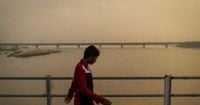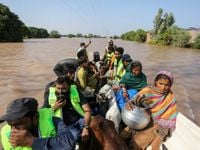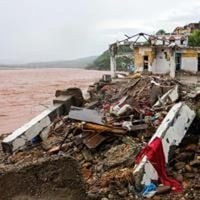Relentless monsoon rains have brought devastation to northern India and Pakistan’s Punjab province, unleashing some of the worst flooding and landslides seen in decades. The toll is staggering: at least 90 people have died and hundreds of thousands displaced in India in recent weeks, while across the border, over 1.8 million people have been forced to flee their homes in Pakistan’s Punjab since August 2025, according to government officials and disaster relief agencies cited by The Associated Press and Al Jazeera.
The scale of the disaster is hard to overstate. In India, the Himalayan Mountain states and territories—Uttarakhand, Himachal Pradesh, Jammu and Kashmir, as well as Punjab and the capital New Delhi—are among the worst hit. The Yamuna River, which runs through the heart of Delhi, breached its danger mark on September 2, prompting the evacuation of nearly 10,000 people from riverbanks and low-lying areas. "We have moved to these tents for now as our homes have been submerged in water. This is just like the 2023 floods," said Rekha Chaturvedi, 55, from the Nigambodh Ghat area, in comments reported by AP.
Flooding has been particularly severe in Punjab state, India’s agricultural heartland. At least 30 people have died and 300,000 have been affected by the deluge. Farmers like Surinder Singh in Kapurthala district have seen their livelihoods swept away. "We have lost paddy, maize, and wheat crops worth over 700,000 rupees ($8,400). Children had to be moved to safer villages. The government visits, but we have received little help so far," Singh told AP. The state government reported that 150,000 hectares of crops have been destroyed, a blow that will echo through the region’s economy for months to come.
In the mountainous regions, the situation is equally dire. Landslides and cloudbursts—intense, localized rainstorms—have battered villages and infrastructure. In August, four people were killed and hundreds went missing after a village in Uttarakhand was hit by landslides and floods. Overflowing glacial lakes in July damaged hydropower dams and destroyed a key bridge linking Nepal to China. Roads have been washed out, disconnecting parts of Jammu and Himachal Pradesh from the rest of the country, according to Reuters.
The human stories behind these numbers are harrowing. Fayaz Ahmad, a 70-year-old farmer on the outskirts of Srinagar in Indian-administered Kashmir, described the sense of helplessness: "We saw extreme heat this year, and now water keeps entering our homes and farms after just a few days of rain. Something has changed. It was never like this in my youth."
Across the border in Pakistan, the situation is equally, if not more, critical. More than 500,000 people were forced to flee in just 24 hours as of September 4, 2025, due to rising floodwaters in eastern Punjab province, according to Punjab Relief Commissioner Nabeel Javed. Since August, 1.8 million people have been displaced, and the flooding has inundated 3,900 villages in Muzaffargarh district alone. Flood levels in some areas rose from a couple of feet to 20 feet within a single day, Al Jazeera reported.
Authorities have scrambled to respond. Tents have been erected in Muzaffargarh, Narowal, and Kasur to house displaced families. Thousands of rescuers and military personnel are involved in ongoing relief operations. To protect Muzaffargarh city, officials made breaches along the Chenab river embankment, a desperate attempt to redirect the surging waters. "Our priority is to save lives as this is the worst flooding in Punjab’s history," said Irfan Ali Kathia, director general of the provincial Disaster Management Authority.
The overall scale is staggering: 3.8 million people have been affected by flooding in Pakistan’s Punjab province, and the crisis is ongoing. "The warning is very clear, this flood is not going anywhere and it’s claiming more and more land, farms and villages by the hour," said Al Jazeera’s Kamal Hyder, reporting from Multan. The floods are the worst since 2022, when climate-induced flooding killed nearly 1,700 people in Pakistan.
The roots of these disasters, experts say, lie in a combination of human-caused climate change and local vulnerabilities. Monsoon rains in South Asia, which traditionally ran from June to September and again from October to December, have become unpredictable and more intense. "We are living in a warmer world, nearly 1.5 degrees hotter than pre-industrial times," said Anjal Prakash, a United Nations climate report author and professor at the Indian School of Business. "The intensity and frequency of such extreme rainfall events will only increase. This is the new normal."
Rapid urbanization, deforestation, and poorly planned infrastructure have only made matters worse. "Natural drainage systems have been destroyed. Rivers are mismanaged. When intense rainfall coincides with such vulnerabilities, disasters like these become inevitable," Prakash told AP. Meteorologist Akshay Deoras of the University of Reading added, "If the rainfall is uniformly distributed, you will not get that much of an impact. But if that rainfall happens, let’s say in a couple of hours or even, for example, the entire month’s rainfall happens in a few days, that is just going to create problems. And that’s exactly what we are seeing."
The numbers back up the warnings. In 2024 alone, Asia experienced 167 disasters—including storms, floods, heat waves, and earthquakes—leading to losses of over $32 billion, according to the Emergency Events Database maintained by the University of Louvain, Belgium. The South Asian region, among the world’s most densely populated and vulnerable to climate impacts, faces a future where such events become more frequent and severe.
Governments are struggling to keep up. In Delhi, schools and colleges have been closed, and authorities have urged residents to remain indoors as more thunderstorms are expected. In Punjab, India, the government has set up relief camps and is attempting to assist nearly 20,000 people evacuated since August 1. Across the border, Pakistani officials are bracing for further surges as India releases water from dams, a move that has triggered multiple flood alerts in recent days.
Yet, as the waters continue to rise, the stories of those affected serve as a stark reminder of the human cost. Ghulam Abbas, who fled his flooded village in Muzaffargarh, recalled, "Those who thought the waters wouldn’t reach them are now being rescued by boat." Zainab Akhtar, living in a government-donated tent, said she has received some food from charities and the government, but many are relying on help from relatives.
Experts stress the need for smarter planning and rebuilding in climate-vulnerable regions. This includes installing early warning systems, preparing local communities for disasters, and, when necessary, relocating infrastructure away from high-risk zones. "Right now, in India, there is no clear vision as to how things could be handled in the future," said Deoras.
As rains are expected to persist for the next several weeks, authorities and residents across India and Pakistan are bracing for more hardship. For many, the hope is not just for the waters to recede, but for a future where such devastation is no longer the norm.






